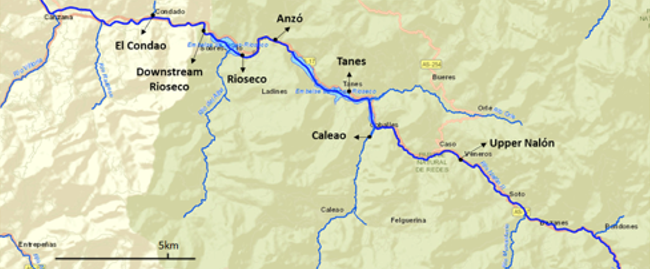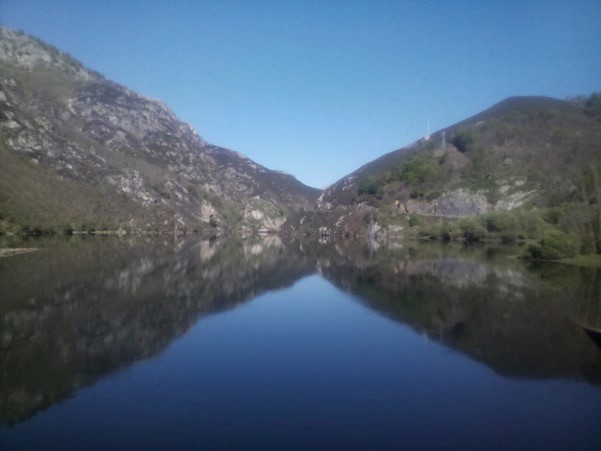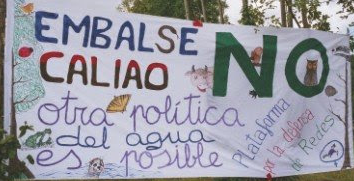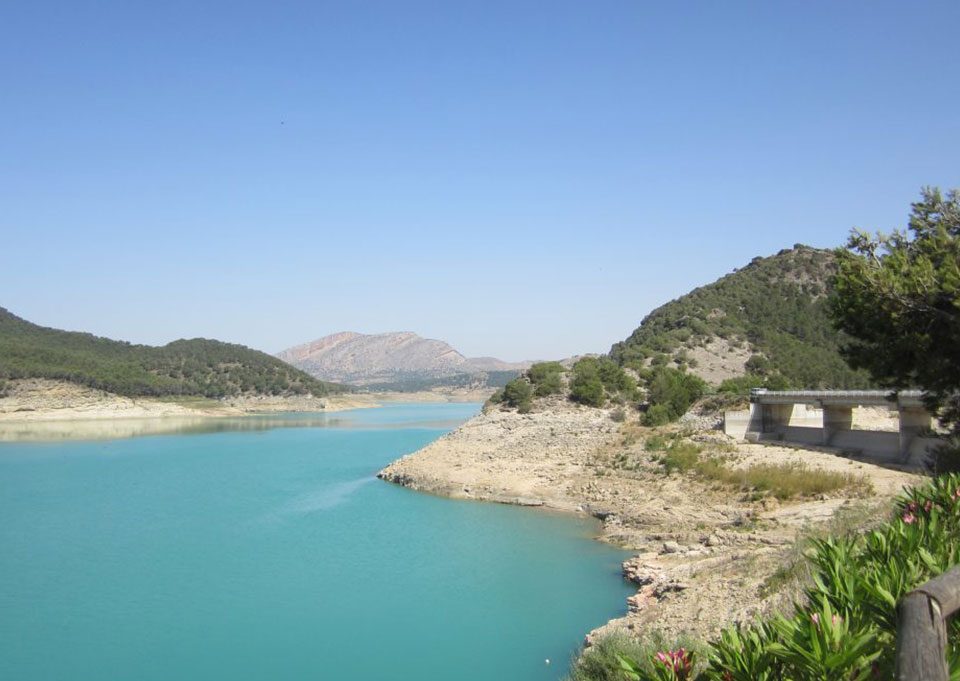Case Study Number: 1
Dam name: Caleao Dam
River name: Nalón
River extension: 153Km
RIVER surface area: 3.692Km2
AMBER TOOLS: Molecular toolkit (D2.5), Ecosystem Services Survey (D2.7), Social survey (D3.5), Barrier Tracker App (D5.4)
River name: Nalón
River extension: 153Km
RIVER surface area: 3.692Km2
AMBER TOOLS: Molecular toolkit (D2.5), Ecosystem Services Survey (D2.7), Social survey (D3.5), Barrier Tracker App (D5.4)
THE NEED
The River Nalón has seven large dams and reservoirs built between 1960 and 1970, two of them (Tanes and Rioseco) within a protected area upstream - Redes Natural Park - that is a Natura 2000 site and Reserve of the Biosphere. A new dam (Caleao) was planned upstream within the protected area, for water and energy supply, including water supply for steel companies, and for compensatory flows to maintain biodiversity (enhancing water quality to be suitable for salmonids downstream). The project was cancelled officially after a decision of Asturias Parliament in 2018.
After its approval, the dam project continued to be much contested by ecological and conservationist associations. The reason being the projected dam would affect the Natural Park of Redes (Natura 2000, LIC, ZEPA, Biosphere Reserve) and several protected species within. A conflict between companies of ecological tourism and the new dam was also expected.
Problems
- Impact on Redes Natural Park (Natura 2000, LIC, ZEPA, Biosphere Reserve)
- Impact on protected species
- Impact on ecological tourism

Map of the case study river with a zoom on the upstream area where Caleao is located. Sampling locations where eDNA was collected are indicated.
WHAT WE DID
Several tools developed in AMBER were applied in the upper zone of the River Nalón, focused on the uppermost reservoirs and the area where the Caleao dam was projected. Here AMBER applied the molecular toolkit (D2.5), educational materials, estimated ecosystem services provided by the dams, carried out the AMBER social survey (D3.5) for understanding society attitudes towards dams, and networked with stakeholders for publicizing the results obtained with these tools, contributing to the conflict resolution.
Tools
- Molecular toolkit (D2.5)
- Ecosystem Services survey (D2.7)
- Social survey (D3.5)
- Barrier Tracker App (D5.4)

Rioseco reservoir within the Biosphere Reserve and Natural Park of Redes, Upper River Nalón.
NOW WHAT
The societal implications and socio-economic impact of the stakeholders involved in the final resolution of the conflict created around the Caleao dam, including AMBER researchers, are enormous. The cancellation of the dam project has already mobilized 60 million euros that will be employed by the public water consortium of the Asturias region (CADASA) for alternative water supply to steel companies of a lower environmental impact. This action implies the safeguarding of the Redes Natural Park and represents a milestone for conservationists and naturalists, as well as for the general public conscious about the environment. AMBER researchers have contributed, perhaps modestly, to create a state of opinion favourable for the cancellation of the Caleao dam project. It is likely the public pressure based on objective information -including AMBER results- helped the politicians and CADASA to find an alternative source of water supply for the Arcelor-Mittal steel company.

Caleao protest camp – a banner against the project.
WHO WAS INVOLVED
On May 11, 2018, the Asturias Parliament (Junta General del Principado de Asturias) approved a Resolution for the Asturias Regional Government to officially announce to the Caleao dam project in the Plan of Water Supply.The proposition was presented by the Izquierda Unida party, on the basis of a new Agreement between CADASA (water consortium) and the multinational steel and mining company Arcelor-Mittal which has investments and interests in Asturias. In that agreement, there is a plan of exploitation of the River Narcea (a branch of the Nalón-Narcea basin) channel, that includes special costs of water for its factory in Veriña (Asturias). Since one of the reasons for building the dam was water supply for steel companies, the Caleao dam project was traded with CADASA for the new agreement.
Following the political decision adopted in the Parliament, the budget project of Asturias Principality for 2019 presented by the Regional Government on December 7 in 2018, and approved November 27 in 2018 in the Junta General del Principado, recognizes the so called Pacto del Narcea (Narcea Agreement) between Arcelor-Mittal and CADASA, and liberates for free CADASA’s use of the 60 million euros retained for the construction of Caleao dam.
Following the political decision adopted in the Parliament, the budget project of Asturias Principality for 2019 presented by the Regional Government on December 7 in 2018, and approved November 27 in 2018 in the Junta General del Principado, recognizes the so called Pacto del Narcea (Narcea Agreement) between Arcelor-Mittal and CADASA, and liberates for free CADASA’s use of the 60 million euros retained for the construction of Caleao dam.
FURTHER READING
References
Fernández, S., Rodríguez, S., Martínez, J. L., Borrell, Y. J., Ardura, A. & García-Vázquez, E. 2018b. Evaluating freshwater macroinvertebrates from eDNA metabarcoding: A river Nalón case study. PLoS ONE, 13(8), e0201741.
Fernández, S., Sandin, M. M., Beaulieu, P. G., Clusa, L., Martinez, J. L., Ardura, A. & Garcia-Vazquez, E. 2018a. Environmental DNA for freshwater fish monitoring: insights for conservation within a protected area. PeerJ, 6, e4486.



